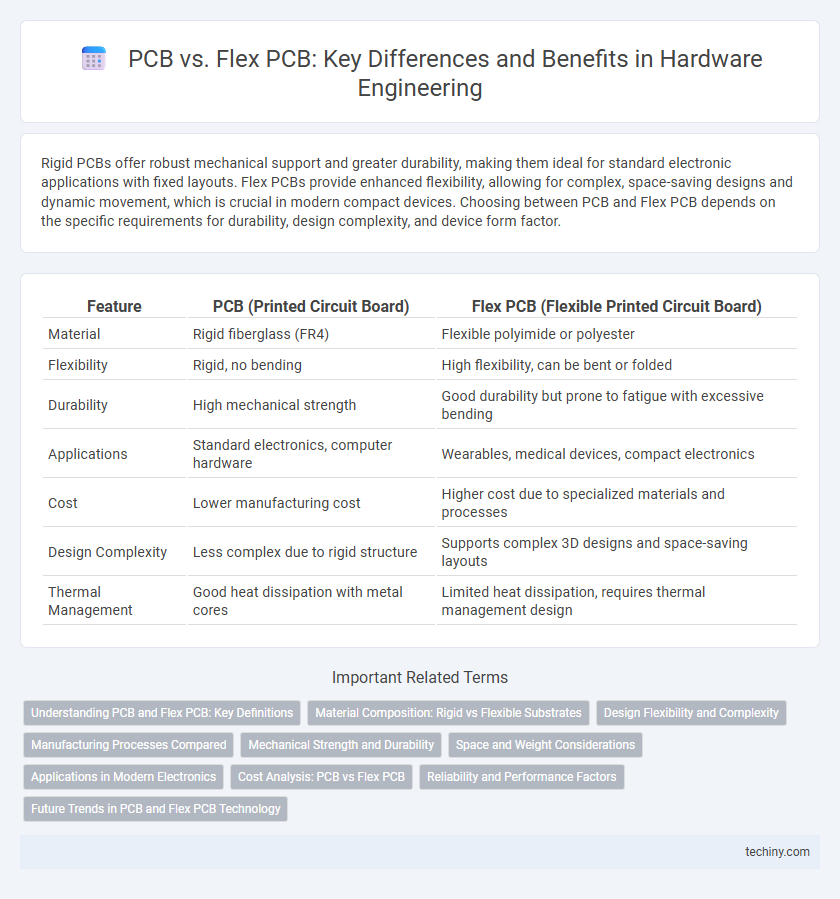Rigid PCBs offer robust mechanical support and greater durability, making them ideal for standard electronic applications with fixed layouts. Flex PCBs provide enhanced flexibility, allowing for complex, space-saving designs and dynamic movement, which is crucial in modern compact devices. Choosing between PCB and Flex PCB depends on the specific requirements for durability, design complexity, and device form factor.
Table of Comparison
| Feature | PCB (Printed Circuit Board) | Flex PCB (Flexible Printed Circuit Board) |
|---|---|---|
| Material | Rigid fiberglass (FR4) | Flexible polyimide or polyester |
| Flexibility | Rigid, no bending | High flexibility, can be bent or folded |
| Durability | High mechanical strength | Good durability but prone to fatigue with excessive bending |
| Applications | Standard electronics, computer hardware | Wearables, medical devices, compact electronics |
| Cost | Lower manufacturing cost | Higher cost due to specialized materials and processes |
| Design Complexity | Less complex due to rigid structure | Supports complex 3D designs and space-saving layouts |
| Thermal Management | Good heat dissipation with metal cores | Limited heat dissipation, requires thermal management design |
Understanding PCB and Flex PCB: Key Definitions
Printed Circuit Boards (PCBs) are rigid substrates that provide mechanical support and electrical connections for electronic components using etched copper pathways. Flex PCBs, constructed from flexible polyimide material, allow bending and conforming to complex shapes while maintaining reliable conductivity. Understanding the distinction between rigid PCB materials and flexible substrates is crucial for optimizing design in space-constrained or dynamic environments.
Material Composition: Rigid vs Flexible Substrates
Rigid PCBs use fiberglass-reinforced epoxy laminate (FR4) as the primary substrate, providing high mechanical strength and stability for complex electronic circuits. Flex PCBs are made from flexible polyimide films, allowing bending and twisting without damaging the circuit, ideal for compact or dynamic applications. Material differences directly impact thermal performance, durability, and design versatility in electronic hardware engineering.
Design Flexibility and Complexity
Rigid PCBs offer straightforward design and reliable performance for standard applications, but they lack the adaptability needed for compact or uniquely shaped devices. Flex PCBs provide superior design flexibility by enabling complex, three-dimensional layouts and dynamic bending capabilities essential for wearable technology and advanced electronics. The increased complexity in flex PCB design requires precise engineering to manage factors like material stress and signal integrity effectively.
Manufacturing Processes Compared
Rigid PCBs involve a straightforward manufacturing process using layered fiberglass and copper sheets, which are etched and laminated to create solid, durable circuits. Flex PCBs require a more complex manufacturing process, incorporating flexible polymer substrates like polyimide and conductive copper traces that are etched with precision to allow bending and folding without breaking. The flex PCB process demands additional steps such as coverlay application and precision laser cutting, increasing production complexity and cost compared to traditional rigid PCB fabrication.
Mechanical Strength and Durability
Rigid PCBs offer superior mechanical strength due to their solid fiberglass construction, making them ideal for applications requiring high durability and resistance to physical stress. Flex PCBs, made from polyimide films, provide excellent flexibility but have lower mechanical strength, making them suitable for devices with complex, compact designs that endure moderate bending. Choosing between rigid and flex PCBs depends on balancing the need for durability against design complexity and mechanical flexing requirements.
Space and Weight Considerations
Flex PCBs offer significant advantages in space and weight reduction compared to traditional rigid PCBs, making them ideal for compact electronic devices and wearables. Their thin, lightweight materials enable complex three-dimensional designs that fit into constrained spaces without adding bulk. This flexibility reduces overall device size and enhances durability by minimizing connectors and solder joints.
Applications in Modern Electronics
Rigid PCBs are widely used in consumer electronics, automotive systems, and industrial equipment due to their durability and stability in mounting complex circuits. Flex PCBs offer exceptional adaptability in wearable technology, medical devices, and aerospace applications by conforming to irregular shapes and enabling lightweight, compact designs. The choice between rigid and flex PCBs depends on the specific mechanical, thermal, and spatial requirements of modern electronic devices.
Cost Analysis: PCB vs Flex PCB
Rigid PCBs typically have lower initial manufacturing costs due to standardized production processes and material availability, making them cost-effective for high-volume applications. Flex PCBs involve higher material and fabrication expenses because of their flexible substrates and complex manufacturing, but they reduce assembly costs by enabling compact, integrated designs and fewer connectors. Evaluating total lifecycle costs is crucial, as flex PCBs can offer savings in maintenance and durability despite higher upfront investments in hardware engineering projects.
Reliability and Performance Factors
Rigid PCBs provide superior mechanical stability and higher durability under harsh environmental conditions, making them ideal for applications requiring long-term reliability. Flex PCBs offer enhanced flexibility and vibration resistance, improving performance in compact or dynamic designs where space constraints and movement are critical. Reliability considerations include thermal management and stress resistance, with rigid PCBs excelling in heat dissipation and flex PCBs minimizing mechanical fatigue through flexible substrate materials.
Future Trends in PCB and Flex PCB Technology
Future trends in PCB and flex PCB technology emphasize increased miniaturization, enhanced flexibility, and integration of advanced materials like graphene for improved electrical performance. Innovations such as embedded components and multi-layered designs enable higher circuit density, essential for wearable devices and IoT applications. The adoption of AI-driven manufacturing processes promises greater precision and reduced production costs in both rigid and flexible PCB fabrication.
PCB vs Flex PCB Infographic

 techiny.com
techiny.com